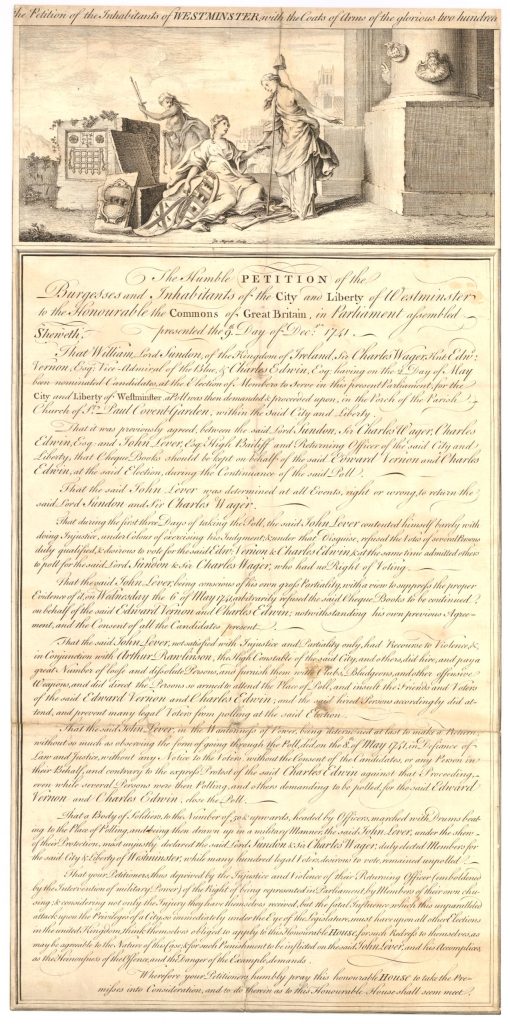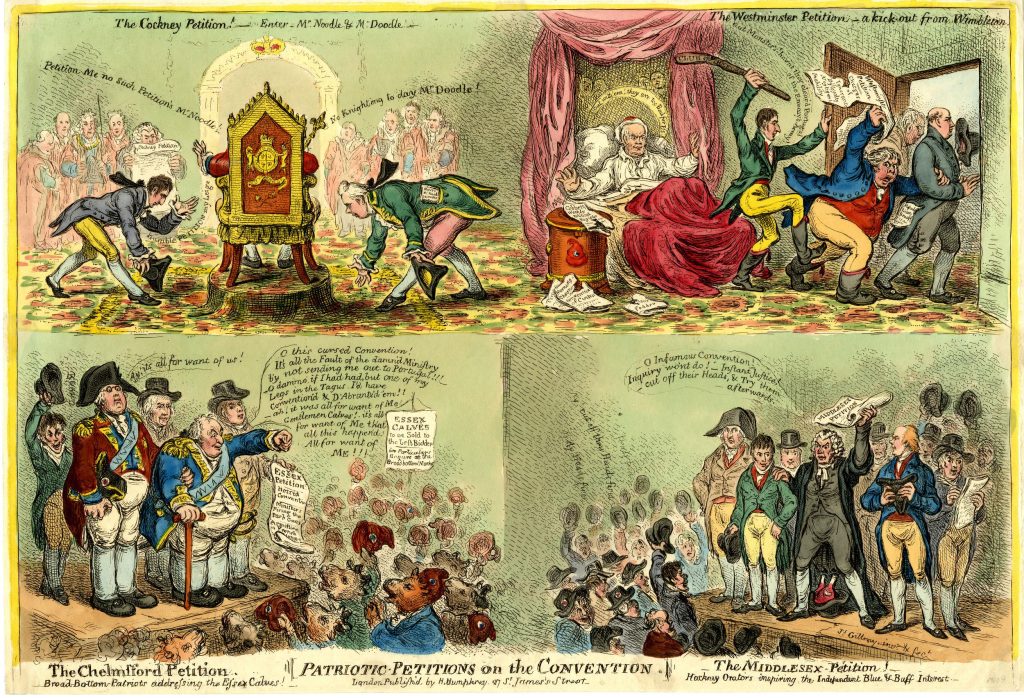Henry Miller argues that petitioning could often engage more people than elections [15-minute read]
Petitions were a complementary and at times alternative form of political participation to elections in the eighteenth century. Like the lively culture of election rituals, petitions enabled participation by people who were not eligible to vote in elections. Just as importantly petitions were a form of representation and a way that groups of subscribers could make claims to represent wider communities of interest when appealing to political authorities such as Parliament or the Crown.[1]
The evolution of petitioning
There was a long tradition of British subjects petitioning Parliament and the monarch, dating back to at least the late medieval period.[2] Indeed eighteenth-century petitioners and parliamentarians often claimed that the right to petition was derived from the Magna Carta of 1215.[3] In the seventeenth century, petitions became a contentious mechanism for mass political mobilisation at moments of crisis like the Civil Wars of the 1640s or the political upheavals preceding the ‘Glorious Revolution’ of 1688.[4] Petitions to Parliament continued to expand up to the 1720s.[5] From the late eighteenth, and particularly, the early nineteenth century there was an unprecedented and sustained increase of mass petitioning Parliament on general public issues (public petitions), whether measured by petitions or signatures. This was driven by organised national campaigns such as anti-slavery, radical reform, or Daniel O’Connnell’s Catholic Association.[6] By the 1820s, thousands of public petitions were sent to the House of Commons every session; by the following decade this figure had increased ten-fold.[7]

Types of petition
Petitions to Parliament were just one type of ‘subscriptional’ (name-signing) culture that existed in the long eighteenth century.[8] Petitions came in many different forms, and were addressed to many different authorities. Anxieties around the role of mass petitions during the Civil War led to the passing of the 1661 Act against Tumultuous Petitioning, which sought to restrict large petitions on potentially explosive political and religious issues, and also limit the number of petitioners who might physically present petitions to Parliament or monarch. One result was that petitions to Parliament for much of the following period focused on more specific, and often, economic questions. Julian Hoppit has estimated that some 38,000 petitions were sent to Parliament between 1660 and 1800, many of them regarding legislation affecting economic interests.[9] Petitions were a regular form through which different interests appealed for or against legislation, taxes, or regulations at this time.[10] For instance, in 1785 manufacturers and merchants from Manchester, as well as many different sectors and regions, petitioned Parliament against the Prime Minister William Pitt’s proposal to equalise the duties between England and Ireland, which was criticised as ‘unjust, unwise, unreasonable, and impolitic’.[11]

While subjects might address general matters of public policy through petitioning the legislature, there were also specific categories of parliamentary petitions that were subject to separate specialised procedures.[12] Beaten candidates or dissatisfied electors might challenge election results through election petitions to Parliament. Following the 1820, 1826, 1830, and 1831 general elections respectively 38, 42, 60, and 20 election petitions were submitted to Parliament.[13] The development of an increasingly distinct process for private bills from the late eighteenth century also reveals the increase in the number of petitions for local or specific legislation. The Private Bill Office received 364 petitions in 1825 and 200 in 1829 for example.[14]
Addresses to the monarch were an important type of petition during the ‘Wilkes and Liberty’ agitation of the 1760s and the American crisis of the 1770s.[15] Late eighteenth- and early nineteenth-century radicals sought to appeal to the Crown as a supreme power that transcended both Parliament and the Government.[16] In 1819, the Prince Regent greeted an address for parliamentary reform from the City of London by declaring, ‘I receive … with feelings of deep regret, this address and petition’.[17] Radicals also maintained that subjects had a right to physically present a petition to the monarch, as it was ‘greatly injurious to the King himself, to be thus cut off from his people’ as William Cobbett argued in 1826.[18] Ultra-Protestants addressed George IV to block Catholic emancipation in 1829, while William IV was deluged with petitions in favour of the reform bill a few years later.[19]
As well as presenting petitions, MPs might receive petitionary ‘instructions’ that tried to treat them as delegates who were mandated to do what their constituents demanded.[20] Yet another genre was the memorial, a type of petition used by merchants and trades to lobby government on matters relating to their economic interests, often including the West India interest in the late eighteenth century.[21] The establishment of chambers of commerce from the late eighteenth century onwards popularised the memorial as the main form through which business lobbies interacted with government.[22]
Authorities such as magistrates or quarter-sessions were also regular recipients of petitions on local topics. In 1737 Henry Maulton, a labourer ‘destitute of habitation’ from Dalbury, Derbyshire, petitioned the justices of the peace to confirm an order from the local manorial court to enable him to erect a cottage for his family.[23]
Petitioners and political participation
As a form of political participation, petitioning was cheap, open, and accessible. Based on clause 5 of the 1689 Bill of Rights, all subjects could claim the right to petition.[24] This did not mean however, that all petitioners were treated equally or given equal weight by authority.
There were a number of important differences between electoral culture and petitions as forms of participation. Petitioning allowed subjects to participate in politics outside of election time, which was not unimportant given the long lags that could exist between elections due to the Septennial Act of 1712. As a form of participation, petitioning was particularly important in Scotland, given that the burgh (or borough) franchise was vested in burgh corporations rather than a popular electorate before 1832.

Petitions could potentially mobilise a broader constituency beyond those permitted to vote in elections. Based on a survey of signatory lists from different boroughs, John Phillips concluded that petitions ‘suggest that the number of politically active Englishmen substantially exceeded the total electorate in the closing decades of the eighteenth century’.[25] Yet Philip Loft has noted that there ‘were multiple layers to the political nation’, and those judged ‘the legitimate participants differed from issue to issue’.[26] In the eighteenth-century context, women signed petitions about certain trades in their capacity as artisans, while women property-owners signed petitions concerning enclosure or canals, but their claim to sign petitions on more general policy beyond their immediate interests or experience was more controversial.[27] By the early nineteenth century however, the broad right of all subjects to petition was increasingly accepted by parliamentarians, paving the way for an explosion of petitioning and an expansion of signatory lists.
Finally, just as there was a wider electoral culture beyond the specific act of voting, so there was a broader culture of petitioning associated with name-signing, including the street politics of leaving a petition to lie for signature in a public place. Many public meetings were called to discuss petitioning Parliament or another authority, with the requisition to the lord lieutenant or corporation to call a meeting serving as a pre-petition.[28]
Petitions then were an important form of participation in the eighteenth century, that offered a variety of opportunities for a broad public to engage with politics at a time when the right to vote was limited.

[1] H. Miller, A Nation of Petitioners: Petitions and Petitioning in the United Kingdom, 1780-1918 (Cambridge: Cambridge University Press, 2023), 229-52; Z. Haaparinne, ‘Voice of the People or Raving of the Rabble? Petitions and Disputes on Political Representation in Britain, 1721-1776’, (University of Jyväskylä, Ph.D. thesis, 2021), 266.
[2] G. Dodd, Justice and Grace: Private Petitioning and the English Parliament in the Late Middle Ages (Oxford: Oxford University Press, 2007); P. Brand, ‘Petitions and Parliament in the Reign of Edward I’, Parliamentary History, 23 (2004), 14-38.
[3] The History of the Two Acts, entitled an Act for the Safety and Preservation of His Majesty’s Person and Government against Treasonable and Seditious Practices and Attempts, and an Act for the More Effectually Preventing Seditious Meetings and Assemblies (London: G.G. and J. Robinson, 1796), 678.
[4] D. Zaret, Origins of Democratic Culture: Printing, Petitions, and the Public Sphere in Early Modern England (Princeton, NJ: Princeton University Press, 2000), pp. 215-60; M. Knights, Representation and Misrepresentation in Late Stuart Britain: Partisanship and Political Culture (Oxford: Oxford University Press, 2005), 103-62.
[5] P. Loft, ‘Petitioning and Petitioners to the Westminster Parliament, 1660-1788’, Parliamentary History, 38 (2019), 342-61, at 346.
[6] Miller, A Nation of Petitioners, 27-49.
[7] Miller, A Nation of Petitioners, 40.
[8] R. Huzzey and H. Miller, ‘The Politics of Petitioning: Parliament, Government, and Subscriptional Cultures in the United Kingdom, 1780-1918’, History, 106 (2021), 221-43.
[9] J. Hoppit, Britain’s Political Economies: Parliament and Economic Life, 1660-1800 (Cambridge: Cambridge University Press, 2017), 153.
[10] P. Loft, ‘Involving the Public: Parliament, Petitioning, and the Language of Interest, 1688-1720’, Journal of British Studies, 55 (2016), 1-23.
[11] Merchants and manufacturers of Manchester, Petition against Anglo-Irish commercial resolutions, 1785, Archives+, Manchester Central Library, M503/1, f. 7.
[12] Miller, A Nation of Petitioners, 74-77.
[13] M. Escott, ‘The Procedure and Business of the House’ in D.R. Fisher (ed.), The History of Parliament: The House of Commons, 1820-1832 (Cambridge: Cambridge University Press, 2009), I, 307.
[14] Parliamentary Papers 1829 (311), Account of Number of Petitions for Private Bills Presented to the House of Commons, 1825-29, XXI, 53.
[15] J. Bradley, Popular Politics and the American Revolution in England: Petitions, the Crown, and Public Opinion (Macon, GA, 1986), 43-119; G. Rude, Wilkes and Liberty: A Social Study of 1763 to 1774 (Oxford: Oxford University Press, 1962), 105-48.
[16] Miller, A Nation of Petitioners, 91-2.
[17] G. Bellew, The Life and Correspondence of the Right Honble Henry Addington, First Viscount Sidmouth (3 vols., London: John Murray, 1847), III, 269.
[18] William Cobbett, ‘To the Readers of the Register on My Petition to the King’, Cobbett’s Weekly Political Register, 5 Aug. 1826, 325. See also S. Poole, The Politics of Regicide in England, 1760-1850: Troublesome Subjects (Manchester: Manchester University Press, 2000).
[19] Draft address to William IV from the inhabitants of Manchester, 19 Oct. 1831, Archives+, Manchester Central Library, M219/1/4.
[20] Knights, Representation and Misrepresentation, 165-6, 195-202.
[21] M.W. McCahill, ‘Introduction’, 1-61, at 2, in The Correspondence of Stephen Fuller, 1788-1795: Jamaica, the West India Interest, and the Campaign to Preserve the Slave Trade, ed. M.W. McCahill, (Oxford: Wiley-Blackwell, 2014), 1-61, at 2.
[22] Miller, A Nation of Petitioners, 96-7.
[23] Henry Maulton, Labourer, Q/SB/2/991, ‘Derbyshire Quarter Sessions: 1730s’, in Petitions to the Derbyshire Quarter Sessions, 1632-1770, ed. Brodie Waddell, British History Online http://www.british-history.ac.uk/petitions/derbyshire/1730s [accessed 16 May 2023].
[24] Miller, A Nation of Petitioners, 110.
[25] J. Phillips, ‘Popular Politics in Unreformed England’, Journal of Modern History, 52 (1980), 599-625, at 624.
[26] Loft, ‘Petitioning and Petitioners’, 350.
[27] Loft, ‘Petitioning and Petitioners’, 355-6.
[28] See R. Huzzey, ‘Public Meetings, Respectable Requisitions, and Popular Politics in Great Britain and Ireland, c. 1769-1850’, English Historical Review (forthcoming).


